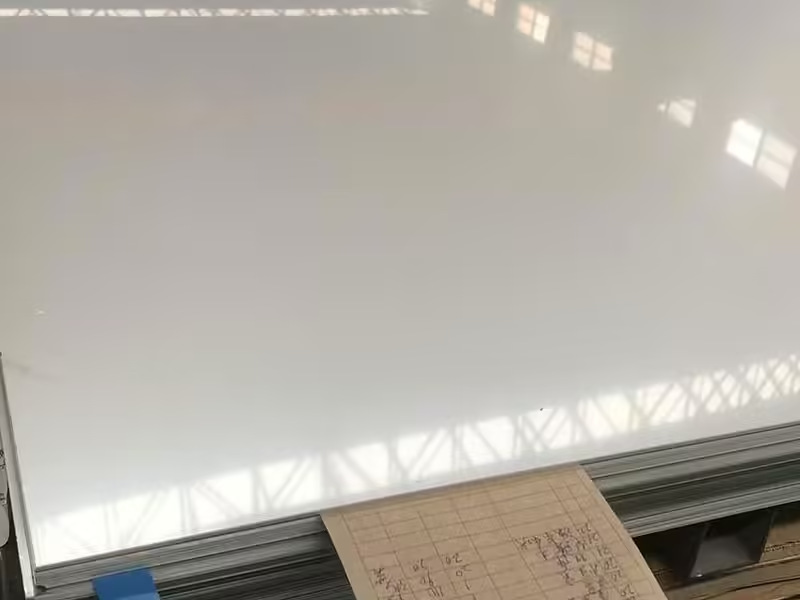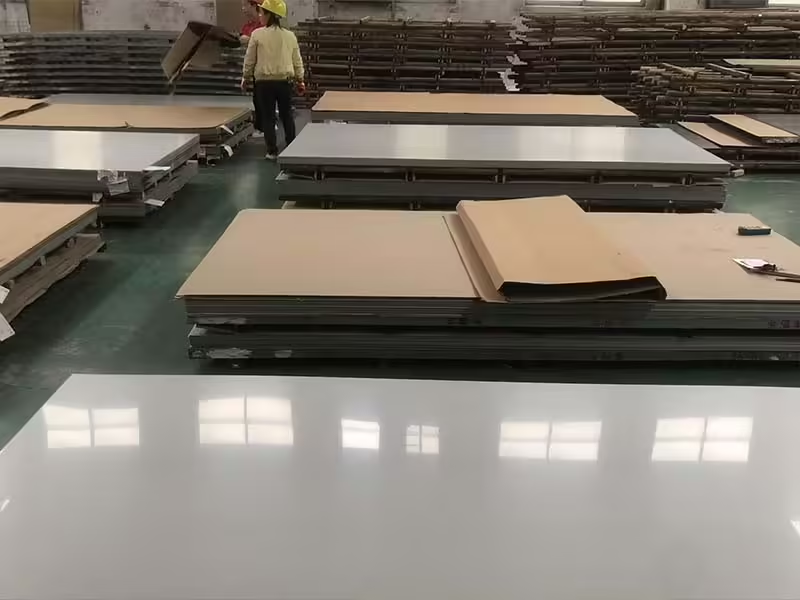내 블로그에 오신 것을 환영합니다!
본론으로 들어가기 전에, 제가 더 많은 정보를 공유하고, 커뮤니티와 소통하고, 업데이트를 게시하는 소셜 미디어 플랫폼에 함께해 주세요. 저와 소통하는 방법은 다음과 같습니다.
페이스북:https://www.facebook.com/profile.php?id=61571539990739
자, 이제 함께 여정을 시작해 볼까요? 여기 있는 내용이 통찰력 있고, 흥미롭고, 가치 있다고 느끼시기를 바랍니다.
목차
소개

미끄럼 방지 강판은 마찰력을 높이고 미끄러짐을 방지하도록 설계된 질감 표면의 특수 강재 제품으로, 건설, 해양, 운송, 제조 등 안전이 최우선인 산업에서 필수적인 부품입니다. 미끄럼 방지 강판의 성능, 내구성, 안전성은 강재의 품질, 즉 화학 성분, 기계적 특성, 제조 공정 등의 요소에 크게 영향을 받습니다.
이 블로그는 강철 품질과 미끄럼 방지 강판 성능 간의 관계를 포괄적으로 살펴보고, 유럽과 그 너머의 전문가들에게 기술적 통찰력, 실용적 응용 프로그램 및 실행 가능한 지침을 제공합니다.
미끄럼 방지 강판 및 강재 품질 이해
미끄럼 방지 강판이란?
미끄럼 방지 강판은 다이아몬드, 셰브론, 스터드와 같은 돌출된 패턴이 있는 평평한 강판으로, 표면 마찰력을 높이고 미끄러짐 및 낙상 위험을 줄이도록 설계되었습니다. 이 강판은 계단, 보도, 차량 경사로와 같이 통행량이 많거나 위험한 구역에서 안전과 내구성이 매우 중요한 곳에 사용됩니다. 미끄럼 방지 강판의 주요 특징은 다음과 같습니다.
- 표면 질감: 융기된 패턴이 그립감을 제공하며, 젖거나 기름진 노면, 얼음이 낀 노면에서 효과적입니다.
- 재료 강도: 일반적으로 탄소강, 스테인리스강 또는 합금강으로 만들어져 강도와 무게의 균형을 이룹니다.
- 부식 저항성: 해양이나 화학 환경에 필수적인 코팅이나 합금 원소로 강화되었습니다.
- 표준 준수: 구조용 강철의 경우 EN 10025, 패턴 플레이트의 경우 ASTM A786과 같은 사양을 충족합니다.
미끄럼 방지 강판의 효과는 강철의 품질에 따라 달라지며, 강철의 품질은 기계적 특성, 내마모성, 환경적 성능을 결정합니다.
미끄럼 방지 강판 사용 시 강철 품질이 중요한 이유
강철 품질은 미끄럼 방지 강판의 성능, 안전성 및 수명에 직접적인 영향을 미치며, 하중을 견디고, 마모에 저항하며, 혹독한 환경에서도 견인력을 유지하는 능력에 영향을 미칩니다. 고품질 강철은 다음과 같은 특성을 보장합니다.
- 안전: 뛰어난 강도와 패턴의 무결성으로 변형이나 표면 마모를 방지하고 미끄럼 방지 기능을 유지합니다.
- 내구성: 부식 및 마모에 대한 저항성이 뛰어나 서비스 수명이 연장되고 교체 빈도가 줄어듭니다.
- 규정 준수: 평탄도에 대한 EN 10163 또는 DIN 51130에 따른 R11–R13 미끄럼 방지 등급 등 엄격한 안전 및 성능 표준을 충족합니다.
- 비용 효율성: 유지관리와 가동 중지 시간을 최소화하여 장기 프로젝트 예산을 최적화합니다.
반대로, 강철 품질이 좋지 않으면 표면 열화, 마찰력 감소 또는 구조적 결함으로 이어져 안전성을 저해하고 비용을 증가시킬 수 있습니다. 따라서 유럽 전역의 안전이 중요한 분야에서 미끄럼 방지 강판을 효과적으로 사용하려면 강철 품질을 이해하는 것이 매우 중요합니다.
강철 품질이 미끄럼 방지 강판 성능에 미치는 영향
화학성분 및 미끄럼방지 강판 내구성
미끄럼 방지 강판에 사용되는 강철의 화학 조성은 강도, 내식성, 내마모성을 결정하며, 이는 모두 강판의 성능에 영향을 미칩니다. 주요 요소는 다음과 같습니다.
- 탄소(C): 일반적으로 탄소강판에서 0.15~0.25%로 하중 지지 용량에 필요한 강도와 경도를 제공합니다.
- 크롬(Cr): 스테인리스 스틸(예: EN 10088에 따른 304 또는 316)은 해양 또는 화학 환경에 중요한 내식성을 향상시킵니다.
- 망간(Mn): 인성 및 내마모성을 향상시켜 보행이나 무거운 하중을 견딜 수 있는 패턴 내구성을 보장합니다.
- 실리콘(Si): 강도와 탄성을 강화하여 동적 적용 환경에서 구조적 무결성을 지원합니다.
최적화된 구성을 갖춘 고품질 강철은 미끄럼 방지 강판이 부식을 방지하고, 패턴의 무결성을 유지하며, 노르웨이의 해양 플랫폼이나 독일의 산업용 바닥과 같은 적용 분야에서 요구되는 환경 스트레스를 견뎌내도록 보장합니다.
미끄럼 방지 강판 사용 시 강의 기계적 특성
항복 강도, 인장 강도, 경도와 같은 강의 기계적 특성은 하중 및 마모 조건에서 미끄럼 방지 강판의 성능에 직접적인 영향을 미칩니다. 주요 특성은 다음과 같습니다.
- 항복 강도: 일반적으로 구조용 강철(예: EN 10025에 따른 S235, S355)의 경우 235~355MPa로, 판이 무거운 하중 하에서 변형을 견뎌낼 수 있도록 보장합니다.
- 인장 강도: 360~510MPa 범위로 계단 밟음판이나 경사로와 같은 용도에 대한 전반적인 구조적 무결성을 제공합니다.
- 경도: 경도가 높을수록(예: 탄소강의 경우 150~200 HB) 내마모성이 향상되고 시간이 지나도 미끄럼 방지 패턴이 유지됩니다.
- 연성: 판이 균열 없이 충격을 흡수할 수 있게 해주며, 통행량이 많은 구역에서 매우 중요합니다.
균형 잡힌 기계적 특성을 지닌 고품질 강철을 사용하여 영국의 건설 현장이나 이탈리아의 식품 가공 공장과 같이 혹독한 환경에서도 미끄럼 방지 강판이 안전성과 기능성을 유지합니다.
표면 패턴 품질 및 미끄럼 방지 강판 효과
미끄럼 방지 강판의 표면 패턴(다이아몬드, 체커, 스터드)은 강재 품질과 제조 정밀도의 직접적인 결과입니다. 고품질 강재는 다음을 지원합니다.
- 패턴 일관성: 균일한 패턴(예: 2~5mm 높이)으로 플레이트 전체에 일관된 견인력을 보장하며 DIN 51130 미끄럼 방지 등급(R11~R13)을 충족합니다.
- 내마모성: 내구성 있는 강철은 반복적인 통행이나 차량 하중에도 패턴이 납작해지는 것을 방지하여 시간이 지나도 그립력을 유지합니다.
- 성형성: 균열 없이 정밀한 엠보싱이나 롤링이 가능하여 생산 중에 깨끗하고 효과적인 패턴을 보장합니다.
품질이 낮은 강철은 패턴이 고르지 않거나, 미끄럼 방지 기능이 저하되거나, 조기 마모를 초래하여 안전성을 저해할 수 있습니다. 따라서 미끄럼 방지 강판의 패턴 품질은 특히 선박 갑판이나 공장 바닥처럼 습하거나 기름진 환경에서 그 효과를 발휘하는 데 중요한 요소입니다.
내식성 및 미끄럼 방지 강판 수명
내식성은 강철 품질의 핵심 요소이며, 특히 해양, 화학, 또는 실외 환경과 같은 혹독한 환경에서 사용되는 미끄럼 방지 강판의 경우 더욱 중요합니다. 내식성을 향상시키는 요소는 다음과 같습니다.
- 합금 원소: 스테인리스 스틸 등급(예: 몰리브덴이 포함된 316) 또는 아연 도금 코팅은 염분이나 산성 조건에서 녹을 방지합니다.
- 표면 처리: 아연 도금(EN ISO 1461에 따름)이나 분말 코팅은 보호층을 추가하여 판의 무게와 마찰력을 보존합니다.
- 제조 품질: 일관된 강철 구성과 깨끗한 표면은 패턴을 손상시킬 수 있는 침식과 같은 국부적 부식을 방지합니다.
고품질 강철을 사용하여 미끄럼 방지 강판이 부식에 강하고, 시간이 지나도 구조적, 안전적 특성을 유지합니다. 이는 북해의 해양 플랫폼이나 프랑스의 화학 공장에서 요구되는 사항입니다.
제조 공정 및 미끄럼 방지 강판 신뢰성
압연, 엠보싱, 절단 등의 제조 공정은 강철의 품질에 영향을 미치며, 결과적으로 미끄럼 방지 강판의 신뢰성에도 영향을 미칩니다. 고품질 공정은 다음과 같습니다.
- 열간 압연: 균일한 두께(예: EN 10029에 따른 3~12mm)와 일관된 기계적 특성을 제공하여 구조적 무결성을 보장합니다.
- 패턴 엠보싱: 정밀한 엠보싱으로 강철 강도를 손상시키지 않고 내구성 있고 균일한 미끄럼 방지 패턴을 만들어냅니다.
- 품질 관리: EN 10163과 같은 표준을 준수하면 안전 응용 분야에 중요한 평탄성과 결함 없는 표면이 보장됩니다.
불규칙한 압연이나 불량 엠보싱과 같은 제조 불량은 패턴이 약해지거나 내부 응력이 발생하여 미끄럼 방지 강판의 신뢰성을 저하시킬 수 있습니다. 따라서 안전하고 효과적인 사용을 위해서는 고품질 제조가 필수적입니다.
강재 품질에 따른 미끄럼 방지 강판 종류 비교표
적절한 미끄럼 방지 강판을 선택하는 데 도움이 되도록, 다음 표는 일반적인 강재 종류, 강재 품질에 따른 특성, 용도 및 성능 영향을 비교합니다. 이 표는 엔지니어와 건축가가 안전성과 내구성을 최적화하는 데 참고 자료로 활용할 수 있습니다.
| 강철 유형 | 주요 속성 | 일반적인 응용 프로그램 | 미끄럼 방지 등급(DIN 51130) | 장점 | 제한 사항 |
|---|---|---|---|---|---|
| 탄소강(S235/S355) | 항복강도: 235~355MPa, 중간 내식성 | 산업용 보도, 계단 밟음판, 건설 현장 | R11–R12 | 고강도, 비용 효율적 | 내식성을 위해 아연 도금이 필요합니다. |
| 스테인리스 스틸(304) | 내식성, 항복강도: 205MPa | 식품 가공, 화학 공장 | R11–R13 | 우수한 내식성, 위생적 | 탄소강보다 강도가 낮음 |
| 스테인리스 스틸(316) | 높은 내식성, 항복 강도: 205MPa | 해양 데크, 해상 플랫폼 | R11–R13 | 염분 환경에 대한 뛰어난 저항성 | 제작이 더 복잡함 |
| 아연 도금 강철 | 아연 도금, 항복 강도: 235–355 MPa | 야외 경사로, 운송 | R11–R12 | 내식성이 좋고 내구성이 우수합니다. | 코팅은 시간이 지남에 따라 마모될 수 있습니다 |
| 합금강 | 고경도(200 HB), 항복강도: 350~500 MPa | 고강도 산업용 바닥, 광산 | R12–R13 | 뛰어난 내마모성, 내구성 | 처리 없이는 제한된 내식성 |
이 표는 강철 품질이 미끄럼 방지 강판의 성능에 어떤 영향을 미치는지 보여주며, 이를 통해 유럽 산업의 특정 안전 및 환경 요구 사항에 맞는 재료를 선택하는 데 도움이 됩니다.
미끄럼 방지 강판의 적용 및 강재 품질

건설 및 인프라용 미끄럼 방지 강판
건설 분야에서 미끄럼 방지 강판은 보도, 계단, 플랫폼 등에 널리 사용되며, 고품질 강재는 안전성과 내구성을 보장합니다. 적용 분야는 다음과 같습니다.
- 비계와 보도: R12 미끄럼 방지 기능을 갖춘 S355 탄소강판은 독일이나 영국의 건설 현장에서 작업자에게 안전한 접근성을 제공합니다.
- 교량 데크: 아연 도금 미끄럼 방지 강판은 부식을 방지하고 실외 환경에서 견인력을 유지하며 EN 10025 표준을 충족합니다.
- 공공 인프라: 이탈리아의 도시 프로젝트에서 볼 수 있듯이, 보행자 다리나 기차역에 스테인리스 스틸(304) 플레이트를 설치하여 위생과 수명을 보장합니다.
고품질 강철은 미끄럼 방지 강판이 무거운 하중과 환경 노출을 견뎌낼 수 있는 능력을 향상시켜 EU 안전 규정(예: EN 1991-1-1)을 준수하도록 보장합니다.
해양 및 연안 환경용 미끄럼 방지 강판
해양 및 해상 응용 분야에서는 특히 습하거나 기름진 환경에서 뛰어난 내식성과 견인력을 갖춘 미끄럼 방지 강판이 요구됩니다. 주요 용도는 다음과 같습니다.
- 선박 갑판: R13 미끄럼 방지 기능이 있는 316 스테인리스 스틸 플레이트는 EN 10088을 준수하여 북해에서 운항하는 선박의 미끄러짐을 방지합니다.
- 해양 플랫폼: 아연 도금 또는 합금 강철판은 노르웨이의 석유 및 가스 산업 종사자들에게 내구성 있고 안전한 표면을 제공합니다.
- 항만 시설: 경사로와 보도의 미끄럼 방지 강철판은 ISO 12944 부식 표준을 충족하여 지속적인 염수 노출에도 안전을 보장합니다.
강철의 품질, 특히 내식성은 미끄럼 방지 강철판이 혹독한 해양 환경에서도 안정적으로 작동하도록 보장하여 안전성을 높이고 유지관리 비용을 줄여줍니다.
운송 및 자동차용 미끄럼 방지 강판
운송 분야에서 미끄럼 방지 강판은 차량, 경사로, 적재 공간에 사용되며, 강철 품질은 안전과 하중 지지력에 영향을 미칩니다. 다음과 같은 용도로 사용됩니다.
- 트럭 침대 및 램프: 다이아몬드 패턴이 있는 탄소강판은 화물 적재 시 견인력을 제공하며, 폴란드나 프랑스의 물류 허브에서 사용됩니다.
- 버스 및 기차 층: 스테인리스 스틸(304) 플레이트는 대중교통에서 위생적이고 미끄러짐 방지 표면을 보장하며 EN 45545 화재 안전 표준을 충족합니다.
- 응급 차량 단계: 합금강판은 잦은 사용에도 높은 내마모성을 제공하여 응급 대응자의 안전한 접근을 보장합니다.
고품질 강철을 사용하여 미끄럼 방지 강철판이 운송 안전과 효율성에 중요한 동적 하중과 마모를 견뎌낼 수 있도록 보장합니다.
산업 및 제조 환경에서의 미끄럼 방지 강판
산업 현장에서 미끄럼 방지 강판은 바닥, 플랫폼, 기계 접근로에 필수적이며, 강철 품질이 안전과 운영 연속성을 결정합니다. 다음과 같은 용도로 사용됩니다.
- 공장 바닥: R12~R13 등급의 합금강판은 스페인이나 독일의 제조 공장에서 내구성과 미끄럼 방지가 뛰어난 표면을 제공합니다.
- 화학 공장: 316 스테인리스 스틸 플레이트는 EN 10028에 따라 화학적 부식을 방지하고 습하거나 기름진 환경에서도 견인력을 유지합니다.
- 광산 작업: 고경도 합금강판은 마모 조건을 견뎌내므로 지하 시설에서 작업자의 안전한 접근을 보장합니다.
산업 현장에서 미끄럼 방지 강판의 성능은 사고를 예방하고 가동 중단 시간을 최소화하여 생산성과 규정 준수를 지원하는 고품질 강철에 달려 있습니다.
미끄럼 방지 강판 제작 및 테스트
미끄럼 방지 강판 품질을 위한 제조 공정
압연, 엠보싱 또는 코팅을 통한 미끄럼 방지 강판 제작은 강판의 품질과 성능에 영향을 미칩니다. 고품질 공정에는 다음이 포함됩니다.
- 열간 압연: 일관된 두께(EN 10029에 따른 3~12mm)와 기계적 특성을 제공하여 구조적 신뢰성을 보장합니다.
- 패턴 엠보싱: 정밀한 엠보싱으로 균일하고 내구성 있는 미끄럼 방지 패턴이 생성되어 체커 플레이트에 대한 DIN 59220 표준을 충족합니다.
- 아연 도금: 패턴 효율성을 떨어뜨리지 않고 내식성을 강화하기 위해 아연 코팅(EN ISO 1461 기준)을 적용합니다.
- 절단 및 마무리: 레이저 또는 플라즈마 절단은 정확한 치수를 보장하여 견인력에 영향을 줄 수 있는 결함을 최소화합니다.
고품질 제작을 통해 미끄럼 방지 강철판은 해양이나 산업용으로 사용하는 데 중요한 안전 및 성능 요구 사항을 충족합니다.
미끄럼 방지 강판 성능 시험 방법
테스트는 미끄럼 방지 강판의 품질과 안전성을 검증하여 기준을 충족하고 예상대로 작동하는지 확인합니다. 일반적인 테스트 방법은 다음과 같습니다.
- 미끄럼 방지 테스트: DIN 51130에 따라 견인력을 측정하고, 습하거나 기름진 조건에서 램프 각도 테스트를 기반으로 R11–R13 등급을 지정합니다.
- 기계 테스트: 계단 밟음판이나 플랫폼에 중요한 하중 지지력을 확인하기 위해 항복 강도와 인장 강도(EN 10025 기준)를 평가합니다.
- 부식 테스트: 염수 분무 시험(ISO 9227에 따름)은 해양이나 야외 용도에 필수적인 녹에 대한 저항성을 평가합니다.
- 표면 검사: 패턴의 균일성과 평탄도를 검사하여(EN 10163에 따라) 플레이트 전체에 걸쳐 일관된 미끄럼 방지 기능을 보장합니다.
이러한 테스트를 통해 미끄럼 방지 강판의 신뢰성이 확인되었으며, EU 표준을 준수하고 까다로운 환경에서도 안전하게 사용할 수 있음을 입증했습니다.
미끄럼 방지 강판 사용을 위한 실용적인 고려 사항
미끄럼 방지 강판 선택을 위한 설계 고려 사항
미끄럼 방지 강판을 선택할 때 강재 품질은 설계 및 안전 요구 사항과 일치해야 합니다.
- 부하 요구 사항: EN 1993-1-1에 따라 차량 경사로와 같은 고강도 강철(예: S355, 항복강도 355MPa)을 선택하세요.
- 환경 조건: ISO 12944에 따라 해양 플랫폼과 같은 부식성 환경에는 316 스테인리스 스틸이나 아연 도금 판을 사용하세요.
- 패턴 선택: DIN 51130에 따라 미끄럼 방지 요구 사항에 따라 패턴을 선택합니다(예: 일반 용도에는 다이아몬드, 교통량이 많은 경우에는 스터드).
- 두께 최적화: 건설이나 운송에 중요한 내구성을 보장하면서 무게를 최소화하기 위해 두께(3~12mm)를 균형 있게 조절합니다.
이러한 고려 사항을 통해 미끄럼 방지 강판은 안전, 성능 및 규제 요구 사항을 충족하고 특정 응용 분야에서의 사용을 최적화합니다.
미끄럼 방지 강판 수명을 위한 유지 관리 및 관리
적절한 유지관리를 통해 미끄럼 방지 강판의 성능과 안전성이 유지되며, 특히 열악한 환경에서는 더욱 그렇습니다.
- 청소: 마찰력을 유지하기 위해 부드러운 세제로 기름, 그리스 또는 이물질을 제거하고 패턴을 손상시킬 수 있는 연마성 세제는 피하세요.
- 부식 방지: EN ISO 1461에 따라 해양 또는 화학 공장과 같은 부식성 환경에서 코팅(예: 아연 도금)을 검사하고 다시 도포합니다.
- 표면 검사: 미끄러짐 방지 기능이 계속 유지되도록, 특히 사람이 많이 오가는 곳에서는 패턴이 마모되거나 변형되었는지 확인하세요.
- 수리 또는 교체: 특히 공공 인프라에서 안전 위험을 예방하기 위해 국소적 손상(예: 침식)을 신속하게 처리합니다.
이러한 관행은 미끄럼 방지 강판의 수명을 연장하여 일관된 안전성과 EN 10163과 같은 표준 준수를 보장합니다.
미끄럼 방지 강판의 환경적, 경제적 이점

환경 지속 가능성 및 미끄럼 방지 강판 품질
미끄럼 방지 강판에 사용된 고품질 강철은 내구성을 향상시키고 자원 소비를 줄임으로써 지속가능성을 지원합니다. 주요 환경적 이점은 다음과 같습니다.
- 재활용성: 강철은 100% 재활용이 가능하므로 폐기된 접시를 특성 손실 없이 재사용할 수 있으며, 이는 EU 순환 경제 목표(예: 지침 2008/98/EC)에 부합합니다.
- 장수: 내구성이 뛰어나고 부식에 강한 플레이트는 교체 빈도를 줄여 건설이나 해양 분야에서 재료 낭비를 최소화합니다.
- 에너지 효율: 가볍고 강도가 높은 판(예: S355)은 구조적 하중을 줄여 운송이나 건축 프로젝트에서 에너지 사용을 낮춥니다.
이러한 친환경적 특징으로 인해 미끄럼 방지 강판은 특히 유럽의 녹색 이니셔티브에 따라 환경적 책임을 우선시하는 산업에 지속 가능한 선택이 됩니다.
미끄럼 방지 강판 품질의 경제적 이점
미끄럼 방지 강판에 고품질 강철을 사용하면 상당한 경제적 이점이 있습니다.
- 유지 보수 비용 절감: 내구성이 뛰어나고 부식에 강한 플레이트는 수리나 교체가 덜 필요하므로 장기적인 비용이 절감됩니다.
- 안전 준수: 고품질 플레이트는 엄격한 표준(예: DIN 51130)을 충족하므로 건설이나 해양과 같은 규제 산업에서 벌금이나 프로젝트 지연을 피할 수 있습니다.
- 운영 효율성: 안정적인 견인력으로 작업장 사고가 줄어들고, 제조나 운송 과정에서 가동 중지 시간과 책임 비용이 최소화됩니다.
이러한 경제적 이점으로 인해 미끄럼 방지 강판은 안전이 중요한 응용 분야에 비용 효율적인 솔루션이 되어 유럽 전역에서 예산이 중요한 프로젝트를 지원합니다.
결론
미끄럼 방지 강판에 사용되는 강철의 품질은 성능, 안전성, 그리고 수명을 결정하는 중요한 요소이며, 건설 현장부터 해양 데크까지 다양한 분야에 영향을 미칩니다. 고품질 강철을 우선시하고 제작, 테스트 및 유지보수에 대한 모범 사례를 적용함으로써 프로젝트에서 미끄럼 방지 강판의 이점을 극대화할 수 있습니다.
자주 묻는 질문
미끄럼 방지 강판이란 무엇이고, 강재의 품질은 사용에 어떤 영향을 미치나요?
미끄럼 방지 강판은 보도나 경사로에 사용되는 미끄러짐 방지용 질감 강판입니다. 고품질 강판은 강도, 내식성, 그리고 내구성 있는 패턴을 보장하여 안전성과 수명을 향상시킵니다.
미끄럼 방지 강판 성능에 강철 품질이 중요한 이유는 무엇입니까?
고품질 강철은 뛰어난 기계적 특성, 내식성, 패턴 무결성을 제공하여 미끄럼 방지 강철판이 EN 10025와 같은 표준에 따라 까다로운 환경에서도 견인력과 안전성을 유지하도록 보장합니다.
미끄럼 방지 강판에는 어떤 종류의 강철이 사용됩니까?
일반적인 유형으로는 탄소강(S235/S355), 스테인리스강(304/316), 아연 도금강, 합금강이 있으며, 각각은 비교 표에서 볼 수 있듯이 적용 분야에 따라 고유한 특성을 제공합니다.
부식 방지 기능은 미끄럼 방지 강판의 수명에 어떤 영향을 미칩니까?
부식 방지 강철(예: 316 스테인리스 또는 아연 도금)은 ISO 12944에 따라 해양 또는 화학 환경에서 녹이 슬지 않도록 방지하여 미끄럼 방지 강철판의 견인력과 구조적 무결성을 보존합니다.
어떤 산업이 미끄럼 방지 강판을 사용합니까?
건설, 해양, 운송 및 제조 분야에서는 보도, 데크, 경사로 및 바닥에 미끄럼 방지 강판을 사용하는데, 이 분야에서 고품질 강철은 안전성과 EU 표준 준수를 보장합니다.

